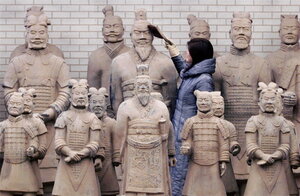How China's Terracotta Army could rewrite history
This discovery calls into question the commonly held belief that Marco Polo was the first European to travel to Asia in 1300 AD, and suggests that this estimate may be off by more than 1,500 years.

A Chinese shopkeeper dusts a statue of China's first Emperor Qin Shi Huang at a souvenir shop in Xian. Making replicas of the Terracotta Warriors and the emperor is a lucrative industry for people living on the harsh and barren plains of Shanxi province, where 26 years ago, Chinese farmer Yang Zhifa accidentally unearthed three of the 7,000 life-sized Terracotta Warriors guarding the tomb of China's first emperor. Although his discovery kicked off one of the greatest archaeological digs in history, local officials awarded him 10 yuan (US $1.20) for each of the three 2,200-year-old statues in 1974. Today, 1.5 million tourists a year visit Xian, a grimy industrial city that once vied with ancient Rome and Constantinople as the greatest metropolis on earth.
Andrew Wong/Reuters/File
Greek sculptors may have helped carve the famous terracotta warriors that have for more than 2,000 years watched over the tomb of Qin Shi Huang, China’s first emperor.
Historians and archeologists excavating the tomb surmise that the statues, which were unusual for the time period, were influenced by Greek sculpture, suggesting that East and West met much earlier than previously thought.
“We now think the Terracotta Army, the acrobats and the bronze sculptures found on site, have been inspired by ancient Greek sculptures and art,” Li Xiuzhen, a senior archaeologist at the site, told the Guardian.
The 8,000 terracotta warriors were first discovered in 1974 by a farmer from Xian, one of China's oldest cities. The warriors were buried underground, presumably to keep their emperor safe in death.
Taking life-sized statues to the grave is reminiscent of Egypt’s King Tut, but there is no evidence of such burial rituals in China either before or after Qin Shi Huang. Additionally, the terracotta statues are incredibly detailed, including decorative hairstyles and armor, but Chinese statues of that era were typically simpler and only about 8 inches tall, the BBC reports.
“I imagine that a Greek sculptor may have been at the site to train the locals,” Lukas Nickel, chair of Asian art history at Vienna University, and a member of the team working on the history of the figures, told BBC News. He added that the Chinese sculptors may have been influenced by Greek statues arriving in Asia after the death of Alexander the Great in 323 BC.
Greek sculpture from that period is known for its realism, suggesting a Greek influence on the warriors’ lifelike appearance. Contemporary Chinese sculpture, by contrast, tended to be more stylized.
Additionally, a European DNA sample found in the nearby province of Xinjian was dated to before the time of the first emperor, suggesting that some westerners may have traveled to and even lived in Asia before the empire formed. While it has long been known that Marco Polo was not the first European to reach China (for one thing, Polo was preceded by his father and uncle), these new discoveries may place the date of the first direct interactions between Europeans and Chinese people to at least 1,500 years earlier.
“We now have evidence that close contact existed between the first emperor’s China and the west before the formal opening of the Silk Road,” Dr. Xiuzhen told the Guardian. “This is far earlier than we formerly thought.”

